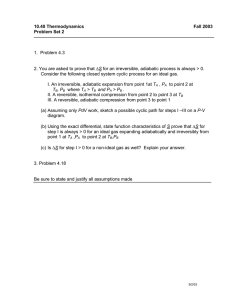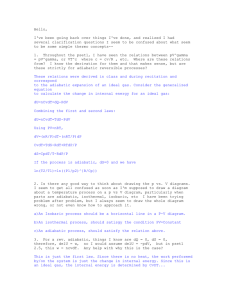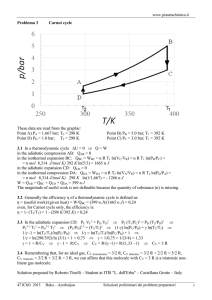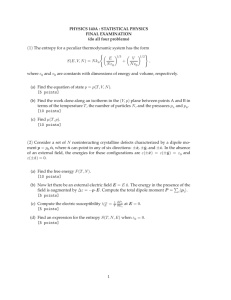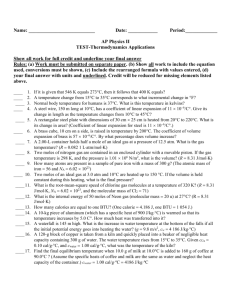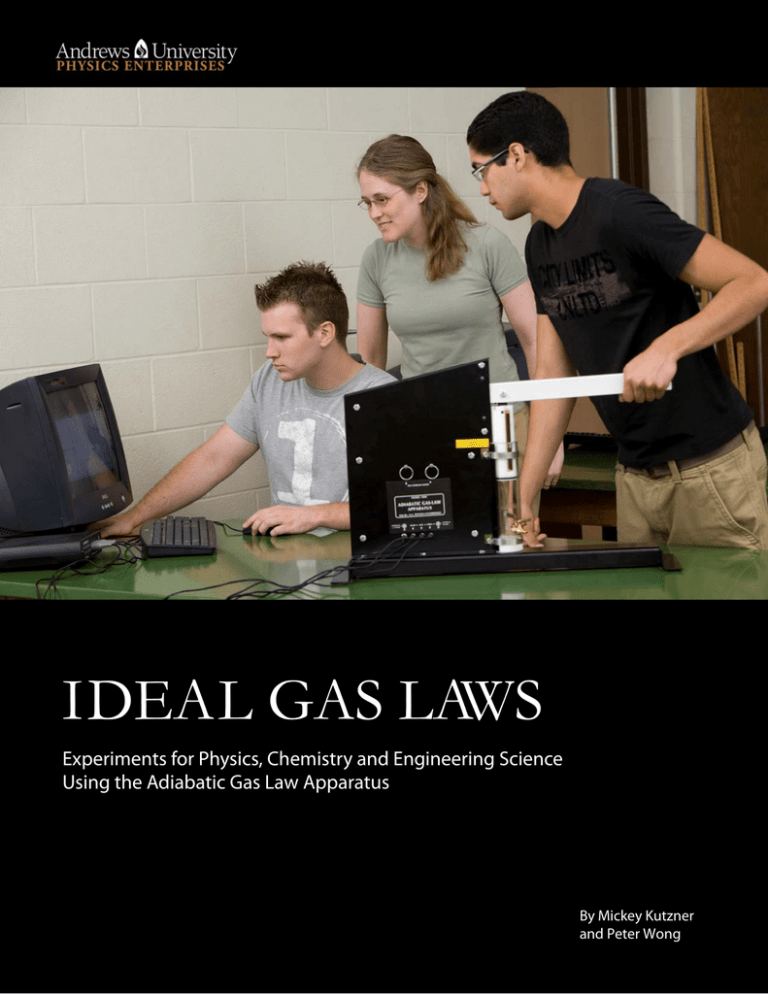
IDEAL GAS LAWS
Experiments for Physics, Chemistry and Engineering Science
Using the Adiabatic Gas Law Apparatus
© 2009 Physics Enterprises
By Mickey Kutzner
and Peter Wong
Copyright © 2009 Physics Enterprises, Andrews University. All rights reserved.
This publication is designed for teaching purposes only. Not for resale.
Thank you for your cooperation on this project:
Dr. Mickey Kutzner—Professor of Physics, Andrews University
Dr. Peter Wong—Professor of Chemistry, Andrews University
Sarah Lee—Ambient Light, Photography
Lubica Mueller—Graphic Design
IMC — Editing
For more information, visit us at www.physicsenterprises.com or contact us:
Ron Johnson, Director
Lubica Mueller, Business Developer
Physics Enterprises
Andrews University
Berrien Springs MI 49104-0384
Ph: 269-471-3503
Fax: 269-471-3509
E-mail: aupe@andrews.edu
2
Table of Contents
Experiment 1: Ideal Gas Law
4
Experiment 2: Isothermal Processes
7
Experiment 2A: Boyle’s Law
Experiment 2B: Work Done by an Isothermal Process
Experiment 3: Adiabatic Processes
11
Experiment 3A: Adiabatic Gas Law
Experiment 3B: Work Done by an Adiabatic Process
Experiment 4: Complete Cycle
16
Experiment 5: Heat Capacity of Gas from PVT Data
20
Appendix A: Calibration of V
22
Appendix B: Additional Analysis to Improve Adiabatic Gas Law Results
23
References
24
© 2009 Physics Enterprises
3
Experiment 1: Ideal Gas Law
Target Students
High school and introductory college physics and chemistry.
Objectives
To show that PV/T = nR for an ideal gas and determine the value of R.
Physical Principles
The well-known relationship between absolute pressure (P), volume (V), and absolute
temperature (T), of an ideal gas is:
PV = nRT
(1.1)
where n is the number of mol in the sample and R is the ideal gas constant. For a closed
system with n fixed, placing all variables on the left-hand side of the equation yields the
constant value,
PV
= nR
T
(1.2)
The number of mol, n, is related to the density of the gas (ρ), the molecular mass of the gas
molecules (M), and the volume (V), via the relation,
n=
ρV
M
(1.3)
Procedure
A. Connections
Power the Adiabatic Gas Law unit via the AC adapter. Insert the Pressure, Volume and
Temperature din connectors into channels A, B and C of the Science Workshop interface,
respectively. Open Data Studio and indicate that a voltage sensor is connected to each
channel. Adjust the Sample Rate to 1,000 Hz.
© 2009 Physics Enterprises
4
Experiment 1: Ideal Gas Law
B. Graphical Display
Drag-and-drop the Graph icon from the Displays menu onto Voltage, Ch A(V) in the Data
menu. Drag-and-drop the Graph1 icon onto Voltage, Ch B(V) and then Voltage, Ch C(V). In
this way, graphs of Pressure, Volume and Temperature will all be displayed with a
common time axis.
C. Collecting the Data
With a stopcock valve open, set the piston to the approximate middle of its range at the
10 cm mark and close both stopcocks.
Record the height of the piston at atmospheric pressure:
h0 = __________ cm
Raise the piston to its highest position, click on Start and, over a span of approximately
five seconds, slowly and steadily move the piston to its lowest position, then click Stop.
Notice that the plots of voltages show the Pressure increasing as the Volume decreases.
Analysis
A. Conversions from voltages to P, V and T
Open the Calculate tool in Data Studio menu and change the Definition to
P = 100000∙x
(Pa)
as noted on the calibration label on the back of the Adiabatic Gas Law Apparatus and
define variable “x” to be Data Measurement with Voltage, ChA(V). Then Accept this
calculation.
In the Calculate tool, click New and define V as the volume according to the linear
calibration expression on the label. This time the variable “x” is defined as Voltage, ChB(V).
Then Accept this calculation. (If you have an older unit or wish to perform the volume
calibration by hand, please refer to Appendix A.
In the Calculate tool, click New and Calculate the Temperature using the linear expression
on the label and defining x as the measurement from ChC.
© 2009 Physics Enterprises
5
Experiment 1: Ideal Gas Law
Use the calculator to define nR = P∙V/T and choose Properties to ensure that the Numeric
display shows at least three significant figures. Plot a graph of nR by selecting the
appropriate title on the vertical axis.
Use the Σ icon on the Graph menu to display the mean value of nR as well as the
standard deviation.
nRmean = ______________ J/K
Std. Dev. = _____________ J/K
What percentage of the mean is the standard deviation?
%random error = 100%∙Std. Dev./mean = _________ %
This is an estimate of the random errors associated with the experiment.
B. Number of mol, n
Calculate the volume of air (in cm3) at the initial 10 cm height when the stopcock was
open to the atmosphere using
V0 = π r2 ho = _________ (cm3)
where r is half the diameter displayed on the label of the Adiabatic Gas Law Apparatus.
Calculate the number of mol of gas from Eq. (1.3), with the density of air at STP of ρ =
0.00129 g/cm3, the volume V0, and the molecular weight of air Mair = (0.8*28+0.2*32) g/
mol (assuming 80% nitrogen and 20% oxygen).
n=
ρ airV0
M air
= __________ mol
Compute your measured value of R.
Rmean = (nRmean)/n = ___________ J/mol·K
Compare your measurement with the generally accepted value of R = 8.314 J/mol∙K.
% Err =
Rmean − 8.314
8.314
× 100% = ____________%
Is this percentage greater or less than the standard deviation percentage?
Should the errors in this experiment be considered primarily random or systematic?
© 2009 Physics Enterprises
6
Experiment 2: Isothermal Processes
Experiment 2A: Boyle’s Law
Target Students
High school and introductory college physics and chemistry.
Objectives
To observe that PV = const for constant temperature.
Physical Principles
When a process occurs with the system in contact with a heat reservoir to keep the
temperature fixed the process is considered “isothermal.” For such a process, the pressure is
inversely related to the volume, i.e.,
PV = const
(2.1a)
Since Eq. (2.1a), Boyle’s Law, can be rewritten as
ln(P ) = − ln (V ) + ln (const )
(2.2a)
one sees that a plot of ln(P) vs. ln(V) should be a straight line with a slope of –1.
Procedure
Convert voltages to Pressure and Volume as in Experiment I using the Calculator in Data
Studio. Set up a graph of P vs. V.
Follow the procedure for the ideal gas law measurements (Experiment I) but slow the
Sample rate to one second and perform the compression slowly and steadily (quasistatically) over the course of a minute-or-so. This allows the temperature of the gas to always
remain at room temperature (isothermal). McNairy [1] recommends suspending a bucket
from the end of the handle and easing weights into the bucket. As you collect data, you can
watch the Pressure adjust to the slow change in Volume.
© 2009 Physics Enterprises
7
Experiment 2A: Boyle’s Law
Analysis
A. Use the Calculator to compute the ln(P) and ln(V) and make a graph of ln(P) on the y-axis
vs. ln(V) on the x-axis. Perform a linear fit and record the slope:
Slope = __________
Compare this with -1.0 as expected for an inverse proportion.
B. Since P = nRT/V, use the Calculator to obtain 1/V and plot P vs. 1/V. Perform a linear fit and
record the slope:
nRT = Slope = _____________
Calculate the volume of air (in cm3) at the initial 10 cm height when the stopcock was
open to the atmosphere using
V0 = π r2 h = _________ (cm3)
where r is half the diameter displayed on the label of the Adiabatic Gas Law Apparatus.
Calculate the number of mol of gas from Eq. (1.3), with the density of air at STP of ρ =
0.00129 g/cm3, the volume V0, and the molecular weight of air Mair = (0.8*28+0.2*32) g/
mol (assuming 80% nitrogen and 20% oxygen).
n=
ρ airV0
M air
= __________ mol
From a plot of T vs. time, use the Σ statistics tool to find the mean (room temperature),
T = __________ K
Now calculate R, R = (nRT)/n·T = (slope)/n·T = __________
Compare your measurement with the generally accepted value of R = 8.314 J/mol∙K.
% Err =
Rmean − 8.314
8.314
© 2009 Physics Enterprises
× 100% =
____________%
8
Experiment 2B: Work Done by an Isothermal Process
Target Students
General physics, physics for scientists and engineers, physical chemistry, engineering
thermodynamics.
Objectives
To observe that the work performed on a gas is given by
W =
∫ P dV
, i.e., the area under a P vs. V curve.
Physical Principles
If the compression occurs isothermally (T remains constant), the Pressure-Volume
relationship is
P=
nRT
V
(2.1b)
and the area under the P vs. V curve becomes,
⎛V
1
W = −nRT ∫ dV = nRT ln⎜ i
⎜V
V
Vi
⎝ f
Vf
⎞
⎟
⎟
⎠
(2.1b)
Procedure
Collect and display data as in Experiment 2A.
Analysis
A. From the plot of Pressure vs. Volume use the Statistics button (Σ), chose Area and record
the area under the P vs. V curve.
Area = ____________ J
© 2009 Physics Enterprises
9
Experiment 2B: Work Done by an Isothermal Process
B. Calculate the number of mol of gas from the density of air at STP of ρ= 0.00129 g/cm3, the
initial volume V0 (in cm3) and the molecular weight of air Mair = (0.8*28+0.2*32) g/mol
(assuming 80% nitrogen and 20% oxygen).
n=
ρ airV0
M air
= __________ mol
C. Record the initial and final heights for the piston,
hi = _________ cm
hf = ___________ cm
Calculate the theoretical value of the work from the ratio of the initial to final height.
⎛V
Wtheory = nRT ln⎜ i
⎜V
⎝ f
% Err =
⎛
⎞
⎟ = nRT ln⎜ hi
⎜h
⎟
⎝ f
⎠
area − Wtheory
© 2009 Physics Enterprises
Wtheory
⎞
⎟=
____________ J
⎟
⎠
×100% = ____________%
10
Experiment 3: Adiabatic Processes
Experiment 3A: Adiabatic Gas Law
Target Students
General physics, physics for scientists and engineers, physical chemistry, engineering
thermodynamics.
Objectives
To observe the adiabatic gas law, PVγ = const and measure the ratio of specific heats, γ, for
various gases.
Physical Principles
When a process occurs quickly enough that no heat is exchanged with the environment
(Q=0), the process is considered “adiabatic.” For such process, the relation between pressure
and volume is given by
PV γ = const
(3.1a)
Here γ is the ratio of specific heats at constant pressure and constant volume, i. e.,
γ =
cP
cV
(3.2a)
A measurement of γ reveals important physical information about the structure of the gas
molecules. The equipartition theorem tells us that the molar specific heat at constant
volume is related to the number of degrees of freedom, f, available to each molecule
through the relation
cV =
f
R
2
(3.3a)
where f = 3 for a monatomic gas with three translational directions of motion, and f = 5 for a
diatomic gas with three translational plus two rotational contributions to the internal
energy.
© 2009 Physics Enterprises
11
Experiment 3A: Adiabatic Gas Law
The specific heat at constant pressure, cP, is related to the specific heat at constant volume
by
c P = cV + R
(3.4a)
Thus, a monatomic gas like He or Ar with f = 3 has the ratio γ = [(3/2 + 1)R]/[(3/2)R] = 5/3.
A diatomic gas like the N2 and O2 mixture found in air has γ = [(5/2 + 1)R]/[(5/2)R] = 7/5 .
CO2 has more complex degrees of freedom such that γ = 1.30.
Experimentally, you will determine γ by observing the relation between pressure and
volume. Since Eq. (3.1a), the adiabatic gas law, can be rewritten as
ln (P ) = −γ ln (V ) + ln(const )
(3.5a)
one sees that a plot of ln(P) vs. ln(V) should be a straight line with a slope of –γ.
Procedure
Follow the procedure for the Ideal Gas Law measurements (Experiment I) with two
differences:
A. Insert a pin in the lower hole as an abrupt stop for the piston motion.
B. The gas should be compressed as rapidly as possible to make the experiment
approximately adiabatic.
Analysis
A. Convert voltages to Pressure and Volume as in Experiment I.
B. Use the Calculator to compute the ln(P) and ln(V) and make a graph of ln(P) on the y-axis
vs. ln(V) on the x-axis. Perform a linear fit and record the slope:
Slope = γ = __________
For air, compare this with 1.40.
Repeat the experiment using argon (or helium) and CO2 comparing with the respective
ratios for these gases.
© 2009 Physics Enterprises
12
Experiment 3B: Work Done by an Adiabatic Process
Target Students
Advanced high school, introductory college physics and chemistry, physics for scientists and
engineers, physical chemistry, engineering thermodynamics.
Objectives
To observe that the work performed on a gas is given by
W =
∫ P dV
, i.e., the area under a P vs. V curve.
Physical Principles
When a gas is compressed under constant pressure, the work performed on the systems is
simply the product of force times displacement or,
W = − FΔy = − PA Δy = − PΔV
(3.1b)
If the pressure changes as the compression occurs, the work done on the gas becomes the
integral
Vf
W = − ∫ PdV
Vi
(3.2b)
corresponding to the negative of the area under a Pressure vs. Volume curve.
If the compression occurs adiabatically, there is no heat exchange with the environment and
by the First Law of Thermodynamics the change in internal energy will equal the work
performed on the gas,
ΔU = Q + W = W
© 2009 Physics Enterprises
(3.3b)
13
Experiment 3B: Work Done by an Adiabatic Process
Thus, when the gas is compressed adiabatically, we can measure the area under the P vs. V
curve and compare with the change in internal energy given by,
ΔU =
f
nRΔT
2
(3.4b)
for an ideal gas with f degrees of freedom.
For the diatomic molecules of air (f = 5) this becomes,
Area =
5
nRΔT
2
(3.5b)
One can also analytically calculate the area under the P vs. V curve by noting
f
Pi Vi γ 1−γ
⎛ V 1−γ ⎤
PV
dV
W = − ∫ PdV = − k ∫ γ = − k ⎜⎜
Vv − Vi1−γ = i i r γ −1 − 1
⎥ =
γ −1
γ −1
V
⎝ 1 − γ ⎦V
Vi
Vi
Vf
Vf
V
(
)
(
)
i
(3.6b)
where r = Vi/Vf is the compression ratio.
Procedure
Follow the procedure for the adiabatic gas law measurements (Experiment 3A).
Analysis
A. Convert voltages to Pressure, Volume and Temperature using the Data Studio Calculator
as outlined in Experiment 3A.
B. Construct a plot of Pressure vs. Volume and expand the view appropriately. Using the
Statistics button (Σ), chose Area and record the area under the P vs. V curve.
(Be careful to highlight data that avoids both ends of the P vs. V curve! The numerical
integration breaks down when the ends are included.)
Area = ____________ J
C. Plot Temperature vs. time and use the statistics to record the minimum and maximum
temperature and compute the change in temperature.
Tmin = ____________K
Tmax = _____________ K
∆T = ___________ K
© 2009 Physics Enterprises
14
Experiment 3B: Work Done by an Adiabatic Process
D. Number of mol, n.
Calculate the volume of air (in cm3) at the initial 10 cm height when the stopcock was
open to the atmosphere using
V0 = π r2 h0 = _________ (cm3)
where r is half the diameter displayed on the label of the Adiabatic Gas Law Apparatus.
Calculate the number of mol of gas from Eq. (1.3), with the density of air at STP of ρ =
0.00129 g/cm3, the volume V0, and the molecular weight of air Mair = (0.8*28+0.2*32) g/
mol (assuming 80% nitrogen and 20% oxygen).
n=
ρ airV0
= __________ mol
M air
Compute the change in internal energy of the air,
ΔU =
5
nR ΔT =
2
____________ J
Compare the change in internal energy with the area under the P vs. V curve.
Compare the area under the curve with the prediction of Eq. 3.6b.
© 2009 Physics Enterprises
15
Experiment 4: Complete Cycle
Target Students
General physics, physics for scientists and engineers, physical chemistry, engineering
thermodynamics.
Objectives
Observe the Otto cycle operating in reverse and compare the ratio of the (work on the gas)/
(heat out of gas) with the Otto cycle efficiency.
Physical Principles
The ideal Otto cycle models the action of a four-stroke gasoline engine and includes the
strokes shown on the PV diagram below:
Ideal Otto Cycle
P-V diagram
P
Combustion
Process
Power Stroke
Work
Heat Rejection
Compression Stroke
V
© 2009 Physics Enterprises
16
Experiment 4: Complete Cycle
The efficiency of any heat engine is defined as,
η=
Work Out
Heat In
(4.1)
This is equivalent to the net area under a P vs. V curve and divided by the heat entering the
system. For the Otto cycle, the work is area between the two adiabatic strokes and heat
enters the system during the isovolumetric combustion stroke.
In this experiment, you will be operating the Otto Cycle in reverse.
Reversed Otto Cycle
P-V diagram
P
V
The procedure begins with an adiabatic compression. The area under the upper-most curve
is the work done on the gas, Won. The gas is then cooled to the original temperature
isovolumetrically, such that Qout = Won . An adiabatic expansion is then followed by
isovolumetric heating with Qin = Wby.
© 2009 Physics Enterprises
17
Experiment 4: Complete Cycle
Though the process is not a heat engine, we can compare the net work done on the gas with
the heat flow out,
ξ=
Wnet Won − Wby
=
Qout
Won
(4.2)
And compare the result with the Otto cycle efficiency which is known to be
η Otto = 1 −
1
r
γ −1
(4.3)
where r is the compression ratio
r=
Vmax
Vmin
(4.4)
and γ is the ratio of specific heats at constant pressure and constant volume (for air, γ = 1.4).
Reversed Otto Cycle
P-V diagram
P
Work
V
© 2009 Physics Enterprises
18
Experiment 4: Complete Cycle
Procedure
Set up the experiment as in Experiment 3 (Adiabatic Gas Law), converting voltages into
Pressure, Volume and Temperature. Set up a plot of Pressure vs. Volume. Put the two pins in
the device to limit the motion of the handle. Raise the piston, open the stopcock and allow
the cylinder to come to equilibrium with its surroundings. Close the stopcock. Once you Start
the data collection, perform the following four steps before you Stop:
1. Quickly compress the piston in an adiabatic compression stroke, continuing to hold the
piston down at the bottom of the stroke. (Stroke 5 to 4 in the Otto cycle diagram).
2. Hold the piston down while an isovolumetric (isochoric) transfer of heat out of the system
takes place. Continue to hold the piston down until you observe that the pressure is no
longer dropping (approximately ½ minute). (Stroke 4 to 3 in the diagram).
3. Quickly raise the piston in an adiabatic expansion and hold up at the top of the stroke
(Stroke 3 to 6 in the diagram).
4. Continue holding the piston up until the cycle on the P-V curve is completed. (Stroke
6 to 5 in the diagram).
Analysis
A. Retake the adiabatic compression stroke only while examining the plot of P vs. V. Use the
Σ statistics button to evaluate the area under this high-pressure, adiabatic curve. (For
numerical reasons, avoid the end points of the P vs. V curve!)
Won = areaupper = __________ J
B. Retake the adiabatic expansion stroke and measure the area under this lower pressure
curve. (Again avoiding the end points).
Wby = arealower = __________ J
C. Calculate the ratio,
ξ=
Won − Wby
Won
=
© 2009 Physics Enterprises
__________
19
Experiment 4: Complete Cycle
D. Compute the compression ratio from the ratio of the maximum to minimum cylinder
heights,
r=
Vmax hmax
=
= __________
Vmin hmin
Calculate the theoretical efficiency of an Otto cycle as
η Otto = 1 −
1
r
γ −1
= __________
Compare with the measured ratio for the Otto cycle in reverse,
ξ=
Won − Wby
Won
You can remove the pins and investigate what happens to the efficiency and the ratio, ξ,
with a larger values of compression ratio, r.
Calculate the ideal efficiency of a gasoline engine where the compression ratio is
normally less than 10:1.
Calculate the ideal efficiency for a diesel engine (assuming that it operates under the
Otto cycle) where the compression ratio is often greater than 22:1.
© 2009 Physics Enterprises
20
Experiment 5: Heat Capacity of Gas from
Pressure, Volume, and Temperature Data
Target Students
Physics for scientists and engineers, physical chemistry, engineering thermodynamics.
Objectives
To illustrate how the abstract mathematics of differential equations can be utilized to obtain
a concrete thermodynamic quantity.
Physical Principles
In physical chemistry the thermodynamic calculations of material properties can be made if
heat capacities of the materials are available. The heat capacity of a gas under constant
pressure, Cp, defined as (∂V/∂T)p, can be derived as Cp = T(∂V/∂T)p(∂P/∂T)S. By following the
same principle for the measurement of the heat capacity of a liquid as described in
Reference 1, analogous measurements to determine the heat capacity of a gas can also be
made.
(∂V/∂T)p and (∂P/∂T)S can be reasonably approximated by finite changes ΔV/ΔT and ΔP/ΔT,
respectively. The change in volume of a gas with temperature can be measured using
standard equipment such as a temperature-controlled water bath and a water manometer.
The change in pressure with temperature requires an apparatus which permits a fast
measurement with negligible heat loss during the change. The Adiabatic Gas Law Apparatus
was chosen because with it a gas could be compressed quickly, and the signals from the
temperature and pressures sensors could be recorded simultaneously.
Procedure
1. Flush the chamber with the sample gas for about 2 minutes. Move the lever up and
down during the flushing to ensure thorough mixing and elimination from the chamber
of air or any previously used gas.
© 2009 Physics Enterprises
21
2. Close all the valves and hold the lever at the highest position. Set the computer interface
(Science Workshop, PASCO) to record temperature on the x-axis and pressure on the
y-axis. Initiate computer acquisition and push the lever down quickly for a rapid
compression of the gas in the chamber.
3. Use the curve-fit program in the software to determine the slope of the displayed trace of
pressure vs. temperature. This will be the experimental value for ΔP/ΔT.
Calculations
1. Multiply the ΔP/ΔT by 2.29† to convert from the voltage slope to kPa/K, and then multiply
by 0.00986 to obtain the unit of atm/K. This calculated ΔP/ΔT will be approximately (∂P/∂T)
S and can be combined with the ΔV/ΔT (∂V/∂T)p from another experiment to determine Cp.
2. Read the height (cm) of the chamber and calculate its volume by
V (cc) = height · Π · (4.51/2)2
3. Use the perfect gas equation (PV=nRT), the calculated chamber volume, the ambient
temperature, and the barometric pressure of the day to estimate the number of mole of
the gas in the chamber.
4. Report Cp in j/K/mol.
Reliability of Results
The calculated results from experiments over many years have been comparable to
literature values. The gases used have been argon and carbon dioxide. For argon, the
average experimentally determined Cp from the years 1995 to 2006 is 31 j/K/mol, while the
literature value is 20.8 j/K/mol. For carbon dioxide, the average over the same period of time
is 41 j/K/mol, and the literature value is 37 j/K/mol. The typical uncertainty in each reported
result has been between 10 and 20 percent.
†
Pressure and temperature calibrations of the Adiabatic Gas Law Apparatus.
© 2009 Physics Enterprises
22
Appendix A: Calibration of V
Necessary for older Adiabatic Gas Law Apparatus models, optional exercise for
newer models
If you have an older unit without the volume calibration, the following procedure will enable
you to determine the Volume/Voltage relation.
Note the diameter of the cylinder printed on the unit and record the radius,
r = ____________ cm = ______________ meters.
Drag-and-drop the Digits icon from the Displays menu onto the Voltage, Ch B(V) in the Data
menu. Open one of the stopcock valves, click the Start button and record the height (h) of
the bottom of the piston and corresponding volume voltage, Vvol for each centimeter over
the range of motion (approximately 6–15 cm).
Table I: Cylinder height vs. Voltage
VVol (Volts)
h (m)
0.06
0.07
0.08
0.09
0.10
0.11
0.12
0.13
0.14
0.15
Close the Digits display.
Use your favorite linear regression method to determine the slope and intercept of this
straight-line relationship.
h = _________ × Vvol + ____________ (meters)
This becomes a relationship between Volume and Voltage using
Volume = π r2 h = _________ × Vvol + ____________ (m3)
© 2009 Physics Enterprises
23
Appendix B: Additional Analysis to Improve
Adiabatic Gas Law Results
A careful examination of the adiabatic data (Experiment 3A) shows a slight time delay
between the piston reaching the minimum volume and the pressure achieving its
maximum. The amount of delay is on the order of the height of the cylinder divided by the
speed of sound. You can adjust the pressure to account for this delay. Drag-and-drop the
Graph icon onto P and the Graph1 icon onto V so that both Pressure and Volume are
displayed on the same scale. Moving the cursor to the numbers on the horizontal scale and
sliding allows you to expand the view until the small time delay between the abrupt
minimum in the Volume and the slightly delayed maximum in Pressure becomes notable.
Use the XY cross hair tool to record the two times to within a millisecond:
tmin Vol = ___________ s
tmax P = ___________ s
Calculate the pressure time delay,
∆t = tmax P - tmin Vol = _________ s (should be a few milliseconds)
Use the Calculator to compute the corrected pressure assuming the first order in a Taylor
series expansion of the pressure with time,
Pcorr = P +
dP
⋅ Δt
dt
(3.6a)
Note that derivates are available under the Special functions found in the Calculator.
Use the Calculator to compute the ln(Pcorr ) and ln(V) and make a graph of ln(Pcorr ) on the yaxis vs. ln(V) on the x-axis. Perform a linear fit and record the slope:
Slope = γ = __________
Has the introduction of pressure time delay into the analysis improved your results?
© 2009 Physics Enterprises
24
References
1. McNairy, William W. Isothermal and Adiabatic Measurements, The Physics Teacher, vol. 24,
178 (1996).
2. Gill, Stanley J.; West, Earl M. The Indirect Determination of Hear Capacity, Cp of a Liquid,
Journal of Chemical Education, vol. 43, 557–559 (1966).
© 2009 Physics Enterprises
25

